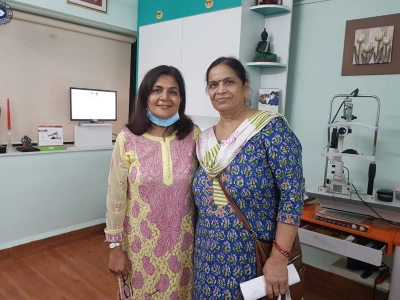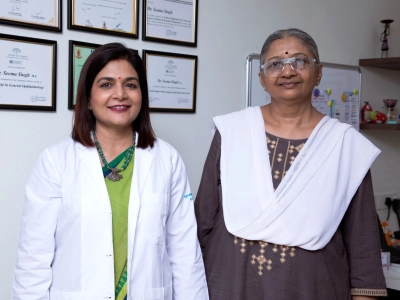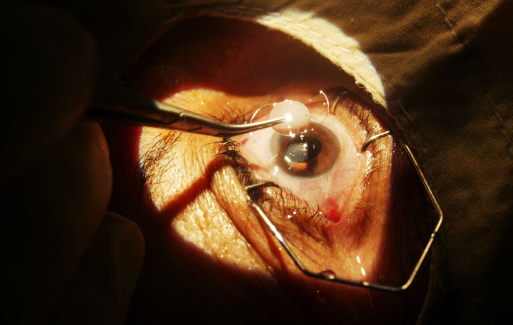The essential cataract surgery involves the removal of cloudy eye lenses (cataracts) and the substitution with clear artificial lenses. This procedure significantly enhances vision for individuals grappling with blurred or cloudy eyesight, proving to be a widely adopted and successful solution for vision improvement. ForCataract Surgery in Mumbai book your appointment with Dr. Seema Behl.

Anesthesia: To ensure your comfort during the surgery, you'll receive local anesthesia in the form of eye drops or a small injection around the eye. This will numb the eye and prevent pain or discomfort.
Incision:A tiny incision is made on the surface of the eye, usually around the cornea, which is the clear front part of the eye.
Phacoemulsification: In most cataract surgeries, a technique called phacoemulsification is used. This involves using an ultrasound device to break up the cloudy lens into small pieces. These fragments are then gently suctioned out of the eye.
Lens Implant: Once the cloudy lens is removed, it's replaced with an artificial lens, often called an intraocular lens (IOL). This clear plastic lens serves the same function as your natural lens and helps to focus light onto the retina at the back of the eye.
Sutures (Stitches):In some cases, the incision may be so small that it doesn't require stitches. However, in other cases, a few stitches may be used to close the incision.
Recovery:After the surgery, you'll be monitored in a recovery area for a short period. It's common for patients to experience improved vision immediately, but full recovery may take a few days or weeks.
Meet Dr. Seema Behl, Cataract Specialist in Andheri has an overall 30 years of experience in her field. She performed thousands of cataract surgeries including traumatic and pediatric cataract surgeries. With a rich 25-year background in renowned Eye Hospitals, has established the "SMART VISION EYE CLINIC" in Andheri, Mumbai. Her mission is to deliver cost-effective, accessible eye care, promoting clear vision and productivity for all.



History of Cataract surgery : In older days, we had to wait for cataract surgery till one lost all vision due to ‘mature’ or ‘ripe’ cataract. We had to wait till the risk involved in surgery would outweigh benefits. Big incision (9 to 12 mm) was made to remove cataract and stitches were applied to seal it. Post-operatively there were lots of restrictions, recovery was slow, stitches caused problems like discomfort, astigmatism, infections etc. Before the intraocular lenses came in practice, patients had to wear thick glasses and quality of vision was not that great.

Advancement in Cataract Surgery – Modern day Cataract Surgery
Last 2-3 decades have seen many breakthrough changes in Cataract surgery. Now we break the cataract by ultrasonic sound waves with a probe vibrating at 40,000 cycles per second and liquefy it and suck it out through a very small incision (1.8 to 2.2 mm). Foldable intraocular lenses are then put through the same incision. This does not require sutures or patching after surgery. Now we don’t give injections also, as surgery can be done after putting only numbing drops. We have to give local anesthesia or eye injection only in situations like very hard or complicated cases. General anesthesia is required only in very rare conditions like uncontrolled Parkinsonism (patient with tremors), dementia, children or extremely anxious and uncooperative patients.The recovery is much faster with the patient returning to normal activities in a matter of day. Hence cataract surgery is done whenever it interferes with your vision and daily activities. We do not have to wait until Cataract becomes totally ripe and patients become blind. Cataract surgery has a very high success rate of 95 to 99 %. Till now, Phacoemulsification is the ultimate method of choice for cataract surgery. Recently, Femtosecond laser has been used for cataract surgeries it can make incisions to correct astigmatism, open the capsule and softens the cataract but has to be used in conjunction with Phacoemulsification to complete the procedure. It is a two-step procedure now. In future, maybe it can develop into exciting technology and the increased cost can be justified in terms of visual benefit.
The natural lens in cataract surgery is replaced by an artificial lens made of acrylic or silicone material. There are many types of lenses available nowadays.
Monofocal Lenses : Can correct the vision problem due to cataract but reading glasses are required.
Monofocal Aspheric lenses :The quality of vision offered by them is better due to their superior technology. The dim light vision, contrast & sharpness is better appreciated.
Toric Lenses:Can correct cylindrical power.
Multifocal Lenses : Are specialized lenses which help in treating the cataract and also getting rid of reading glasses.The dependence on any kind of glasses is reduced by almost 95-98%. Patient opting for multifocal lenses do not require glasses for watching TV, reading newspaper, computer work or any kind of routine activities.
Secure your cataract consultation now with Dr. Seema Behl for personalized care and enhanced sight.
Call:+91 9321842424
For Directions: Smart Vision Eye Centre

